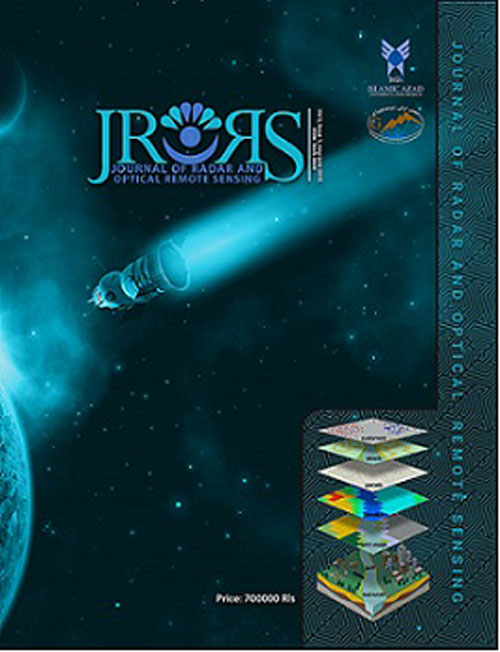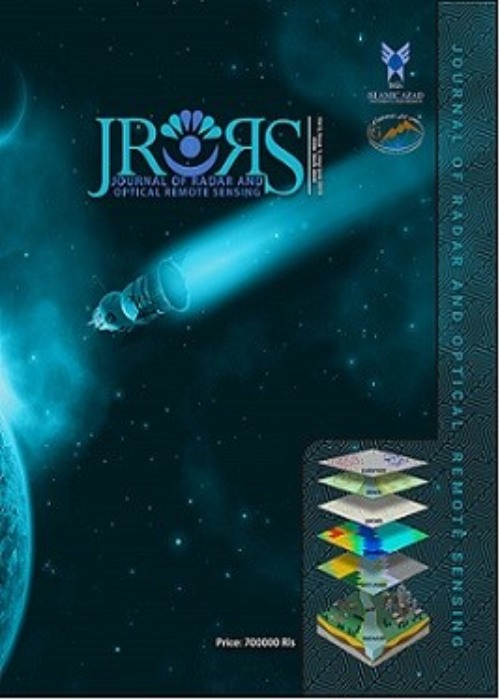فهرست مطالب

Journal of Radar and Optical Remote Sensing
Volume:4 Issue: 3, Summer 2021
- تاریخ انتشار: 1401/04/18
- تعداد عناوین: 6
-
Pages 7-16Conventional cameras based on an array of pixels (CCD or CMOS) are commonly used to capture a target image at a certain distance. In this type of camera, all pixels are used to create the image. For CCD-based cameras at other wavelengths, including infrared and terahertz, having all the pixels increases the cost of the camera. The aim of this study is to design and build an imaging setup using a single pixel method to reduce the cost of the camera and to reconstruct the target image using less data. We verify this method for visible band due to availability of visible light equipment that can be generalized this method to other wavelengths. We use a spatial light modulator (SLM) produces two-level optical masks with random distribution with 20 x 20 pixels and a size of 10 x 10 cm and illuminates the target at a repetition rate of 1 Hz. The reflection of each mask from the target captured by a CCD camera and then we average of all pixels of the CCD to equate it with a single-pixel detector. The target image is reconstructed using a compressive sensing algorithm. The process of reconstructing the target image is performed using a minimum number of masks. We use the two norms L1 and TV to retrieve the target image. The simulation results show norm TV is more successful in target image retrieval. Also, with increasing the number of masks, the success rate in retrieving the target image increases.Keywords: Single Pixel Method, Mask, Spatial Light Modulator, Compressive Sensing, Measurement, pattern
-
Pages 17-28
Detecting changes is one of the basic needs in the management and evaluation of natural resources. Modeling the process of land cover changes over time using multi- time data in the GIS environment can act as one of the most important factors in managing the mentioned changes. In order to modeling the process of land cover changes and to investigating the possibility of predicting it in the future, land change modeling (lcm) has been used. Therefore, the Landsat TM5 analyzer data of Heev village in Alborz province for the years 1985T 2000 and 2011 were analyzed. Next, using the maximum similarity method, land cover maps of each image for the mentioned years, was extracted and categorized into five layers of vegetation, city, asphalt, barren lands (soil) and rocks and cliffs. The extracted accuracy evaluation coefficients (overall accuracy and kappa coefficient) indicate the high accuracy of this classification method. The analysis of the results obtained from the studies conducted on the two periods of 1985-2000 and 2000-2011 shows an increase in urban construction with a decrease in vegetation, and even in some areas, the disappearance of vegetation, while the village is expanding towards the mountainside. Using the combination of Markov model and automatic cell maps land use prediction maps for the next 16 years were obtained, while the kappa coefficient was used to determine the prediction compliance, and comparing them with the actual map
Keywords: LCM, Markov chain, Automated Cells, Kappa coefficient -
Pages 29-36Knowledge of the quantitative and qualitative characteristics of changes in environmental planning, land- use planning and sustainable development is of great importance and today, the use of vegetation maps is one of the key pillars in information production for macro and micro- planning, and vegetation considered as one of the most important components of any ecosystem. Determining the percentage of vegetation in order to understand the interactions between the Earth and the atmosphere, its effect on climate, soil erosion, drought surveying, and natural resource management is essential. Since most of the methods proposed to assess drought conditions so far estimate drought indices based on stationary data at one point, researchers were looking for a way to better achieve regional estimates in order to better manage the damage caused by this gradual phenomenon. Therefore, in this research, remote sensing and Landsat 8 satellite imagery techniques and Infrared Percentage Vegetation (IPVI), Normalized Difference Vegetation Index (NDVI), Weighted Difference Vegetation Index (WDVI), Soil Adjusted Vegetation Index (SAVI), Optimized Soil Adjusted Vegetation Index (OSAVI) and Modified Soil Adjusted Index (MSAVI) were used to calculate the percentage of vegetation and the Modified Perpendicular Drought Index (MPDI) was used to estimate regional drought. After preparing the drought map, the areas which were in mild, moderate and severe drought in terms of severity, were well classified.Keywords: Vegetation, drought, remote sensing, Satellite Images
-
Pages 37-49
By increasing the development of Geographical Information Systems (GIS) providing electronic map data exchange with internet and mobile applications, related problems such as keeping secure map information, safe transactions, and assured broadcast services are necessary. Every year millions of attacks on financial and data information will be caused a series of problems in the world. One of the most critical attacks on the application level is SQL injection into the Web database. This paper tried to present a model for preventing SQL injection into GIS applications, which leads to fetching and manipulating the map information and data from a database. It also provides solutions for IT managers to keep the GIS website secure. The model security steps were tested on one of the GIS portals of Iranian organizations. To evaluate the performance of the proposed model, the security of an Iranian web GIS was checked before and after the announcement of the instructions, and the test results of the vulnerability checking with Acunetix and DVWA. The result showed that the website was completely safe and the model’s instructions for various stakeholders, including programmers, administrators, and GIS experts can significantly prevent this attack.
Keywords: SQL Injection, Web GIS Application-Level Vulnerabilities, Authentication, Authorization, Data Integrity, Application Security Scanner -
Pages 51-58
Pressure, as one of the practical and controllable factors in water distribution networks, has an essential role in how water is distributed. On the other hand, pressure control in implemented networks, is possible only by adjusting the control valves. In order to standardize and improve the quality of water supply projects along with minimizing economic problems, the use of relevant rules, criteria, and standards is inevitable and necessary. In the present study, using the spatial information of the study area, including the raster layer of the digital model of region’s elevation and the layer point of the location of pressure breakers and water tanks, a data bank was first prepared. Interpolation maps were generated with 95% accuracy, and six-month periods were compared based on these maps. The results showed that the first and fourth periods of the study of water pressure fluctuations were similar. This study established the effect of time on the spatial distribution of water pressure based on the final maps.
Keywords: Water Pressure Fluctuation, Reservoirs, Kriging, Geographic Information System -
Pages 58-80
One of the effects of a gradual population increase in the urban areas is waste in crescent and its disposal. Among the common methods of waste management, land filling is technically, ecologically and economically important. The purpose of this study is to determine the appropriate spatial potential for sanitary landfill of waste in Rasht, based on location criteria and using GIS and remote sensing. Zoning of suitable burial sites was done based on the 4 main criteria of land use, hydrological characteristics, geological characteristics and accessibility. In a current study, SRTM sensor data, which is paired with a short time interval (to reduce changes occurring at ground level) was used to prepare a digital model of land. The maps derived from the digital model of land, included elevation and slope maps that were used to prepare the criteria of the "geological profile." After standardization and preparation of maps, in order to achieve the weight and importance of each layer to find suitable landfills, the weight of the layers used was calculated by hierarchical analysis method. Considering the effective factors in locating the municipal waste landfill and weighing each of the criteria and sub-criteria, five values of very suitable, suitable, relatively suitable, inappropriate and very inappropriate were specified. To determine the priority of the very suitable areas, the TOPSIS method was used. Among the 9 sites introduced to the TOPSIS algorithm, site four, with an area of 89.36 hectare, which is located in the southern parts of Rasht, was determined as the most suitable place for waste disposal.
Keywords: Waste, hierarchical analysis, GIS, Location


